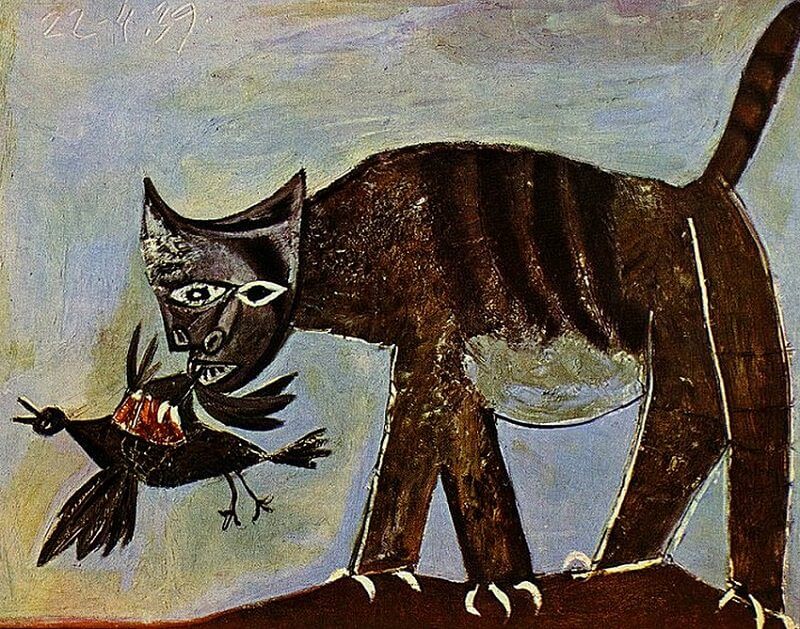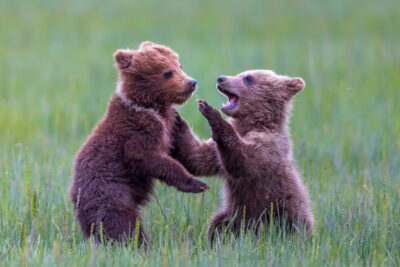| Creator | Pablo Picasso |
| Media Form | Painting |
| Genre | Animal Painting |
| Technique | Oil, Canvas |
| Date and Location of Creation | Musée Picasso, Paris, France |
| Publication Information | Posted On Picasso Website |
| Species Information | Cats |
Picasso’s “Cat Catching a Bird” from 1939 is this really cool painting where you see a cat in action, trying to catch a bird. The colors he uses are bold and stand out, and since Picasso is known for Cubism, he chops up shapes and puts them back together in this funky, unique way. It’s like he’s catching the cat’s quick move with these colorful puzzle pieces.
What’s even more interesting is how those bold colors don’t just look cool; they also show the urgency of the moment. It’s like you can feel the energy of the cat going for the bird. And with all those chopped-up shapes, it’s not just one point of view, it’s like looking at the action from a bunch of angles at the same time. I guess, that’s just Picasso’s style, breaking the rules and making you see things in a fresh way.
When you look this painting, you’re not just seeing a cat and a bird – you’re getting pulled into this dynamic scene with shapes and colors bouncing around. It’s like Picasso turned a simple moment into this lively, expressive work of art that makes you look twice.
In today’s world, our relationship with animals went through a lot of change. Once wild creatures roaming the untamed wilderness, many animals have seamlessly integrated into our homes and hearts, becoming cherished members of our families. Among these, house pets stand out as prime examples of this remarkable shift in perception. No longer merely domesticated animals, they are beloved companions, offering unwavering loyalty, unconditional love, and immeasurable joy to millions of households worldwide. The way we view and treat our house pets reflects not just our evolving attitudes toward animals, but also the deep emotional connections we form with these furry, feathered, or scaly friends. In this blog post, we’ll delve into the fascinating journey of how house pets have transitioned from wild creatures to cherished domestic companions, exploring the societal shifts, emotional bonds, and the enduring love that defines our relationship with them today.
According to an article written by The Editors of Encyclopaedia Britannica, “…the initial steps toward domestication were taken largely through the widespread human practice of making pets of captured young wild animals.” This early form of domestication was a big change for us, creating bonds and understanding between humans and animals. This strong interest to care for and live with different species has continued over time, influencing the different and complex connections between people and their animal friends.

Today’s pet cats started out as wildcats that people tamed around 9,000 years ago. As time went on, people chose cats with certain traits, and that’s how we ended up with all these different cat breeds. Now, cats are popular pets everywhere, cause they’re friendly, good at hunting, and make awesome buddies for families. But, you know, even though we see them as cute and cuddly, it’s worth mentioning that cats can also be a bit risky sometimes.
So, there’s this show called “My Cat From Hell” and it is all about our cute little cats and the not so cute side of them. Turns out, they can be a bit wild. It shows real life situations where cats act up or get aggressive, pointing out that these pets still have some of their wild instincts. Jackson Galaxy, the expert on the show, deals with these situations and stresses the importance of knowing how cats roll. The show reminds us that even though we love our cats, they can sometimes be a handful. It’s a wake up call that, despite their adorable looks, cats, just like their wild ancestors, have a natural urge to defend themselves. It’s a reminder to be responsible pet owners and get what makes our cats tick.

So, there’s this episode on “My Cat From Hell” that introduces Lux, a cat going nuts with aggression. His owners even called 911, things were so crazy. But then Jackson Galaxy, the cat guru, stepped in. He figured out that Lux was just super anxious from too much excitement and not enough ways to chill out. With some smart moves, like structured playtime and a more thought out living space, Galaxy gave Lux the mental and physical action he was craving. Lux had the relaxation he needed. It’s a cool story that shows how understanding what a cat needs and bringing in the right fixes can totally change their behavior.
Okay, so some cats can get a bit aggressive, and it’s kinda tied to their wild side. Since domestic cats are basically descendants of wildcats, they’ve got these natural behaviors, like defending themselves when they’re freaked out. In the wild, being aggressive is like a survival thing. But, since we’ve tamed them, not all cats go full-on tough guy. If you give them a good social life, positive vibes, and lots of love, it can chill out their aggressive side. That way, they can live all cozy with us humans. According to an article written by Melanie Deisz, cats will attack because they are feeling fearful or defensive, territorial, playing, redirected, pet induced, pain induced, maternal, and idiopathic. This can all be related to their “wild” instincts.

Both dogs and cats, bring a ton of joy into our lives, but it’s important to recognize that they, too, can display potentially harmful behaviors. Dogs, known for their loyalty and affection, can sometimes exhibit aggression, especially if they feel threatened or anxious. According to an article made by the VCA Animal Hospital, this aggression can stem from their natural instincts to protect themselves or their loved ones. While training and socialization play vital roles in curbing aggressive tendencies, it’s crucial for dog owners to understand their pets’ cues and provide appropriate guidance. Just like cats, dogs also have unique personalities and triggers, and being attuned to their body language is essential in preventing aggressive behavior. Responsible ownership, training, and creating a safe environment are key factors in ensuring a peaceful coexistence with both our canine and feline companions. By acknowledging their potential for aggression and addressing it with understanding and patience, we can foster a safer environment for both pets and their human families, nurturing a bond built on trust and respect, regardless of whether our companions have tails or whiskers.
Dogs and cats bring a bunch of happiness to our lives, they can sometimes act up in ways that aren’t so great. Dogs, all loyal and loving, might throw some aggression our way, especially if they’re feeling threatened or stressed. According to an article made by the VCA Animal Hospital, this aggression can stem from their natural instincts to protect themselves or their loved ones. Training and getting them used to social stuff are important in toning down the aggressive vibes, but us dog owners need to pay attention to our fur buddies’ signals and guide them right. Just like cats, dogs have their own personalities and triggers, and reading their body language is key to preventing them from going feisty. Being a responsible owner, giving them good training, and setting up a safe space those are the things that make hanging out with our furry pals chill. Understanding and handling their tendency to misbehave patiently and compassionately creates a safe space for both pets and their human friends. It’s all about building up trust and respect, whether they wag tails or flick whiskers.
My Cat From Hell (Ed.). (2023, October 21). My Cat From Hell. Wikipedia. https://en.wikipedia.org/wiki/My_Cat_from_Hell
The Editors Of Encyclopaedia Britannica. (2023, October 26). Pet. Encyclopædia Britannica. https://www.britannica.com/animal/pet
Deisz, M. (2019). How to handle a cat attack and what to do to prevent it: Cat behavior. Meowtel. https://meowtel.com/blog/post/how-to-handle-a-cat-attack-and-what-to-do-to-prevent-it
Horwitz, D. (2023). Dog behavior problems – aggression to family members – introduction and safety: VCA Animal Hospitals. Dog Behavior Problems – Aggression to Family Members – Introduction and Safety. https://vcahospitals.com/know-your-pet/dog-behavior-problems-aggression-to-family-members-introduction-and-safety#:~:text=The%20most%20common%20causes%20include,guarding%20aggression%20and%20redirected%20aggression.
Picasso, P. (1970, January 1). Cat catching a bird, 1939 – Pablo Picasso. www.wikiart.org. https://www.wikiart.org/en/pablo-picasso/cat-catching-a-bird-1939
Picasso, P. (1939). Cat catching a bird, 1939 by Picasso. Cat Catching a Bird, 1939 by Pablo Picasso. https://www.pablopicasso.org/cat-catching-a-bird.jsp#prettyPhoto




